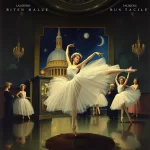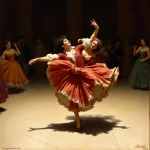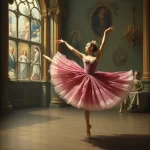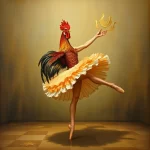Ballet: La Boutique fantasque (Ottorino Respighi, 1919)

Introduction
La Boutique fantasque, also known as The Magic Toyshop, is a one-act ballet that premiered in 1919. The ballet was choreographed by Léonide Massine, with music composed by Ottorino Respighi. The premiere took place at the Alhambra Theatre in London, performed by Sergei Diaghilev’s Ballets Russes. The ballet tells the whimsical story of a magical toyshop where the toys come to life, featuring a blend of humor, romance, and fantasy.
Historical Background
Creation and Development
La Boutique fantasque was created during a period of significant artistic innovation in the early 20th century. The Ballets Russes, under the direction of Sergei Diaghilev, was at the forefront of this movement, known for its avant-garde productions that combined music, dance, and visual art. The inspiration for the ballet came from a French vaudeville piece titled La Boutique fantasque by Alfred de Musset. The collaboration between choreographer Léonide Massine and composer Ottorino Respighi was crucial in bringing this enchanting story to life. Respighi adapted piano pieces by Gioachino Rossini, infusing them with his own orchestral flair to create a vibrant and playful score.
Premiere and Reception
The ballet premiered on June 5, 1919, at the Alhambra Theatre in London. The initial reception was overwhelmingly positive, with critics and audiences praising the ballet’s charm, humor, and innovative choreography. Notable early performances included revivals by the Ballets Russes and other prominent ballet companies, solidifying its place in the repertoire of 20th-century ballet.
Synopsis of the Ballet
La Boutique fantasque is a one-act ballet that unfolds in a magical toyshop. The story revolves around a pair of can-can dancer dolls who fall in love and the adventures that ensue when they are sold to different buyers.
Detailed Summary
The ballet opens in a bustling toyshop, where a toymaker is busy preparing his creations for display. The shop is filled with a variety of toys, each with its own unique personality. The toymaker winds up the toys, bringing them to life for the amusement of potential buyers. Among the toys are a pair of can-can dancer dolls who perform a lively dance, captivating the audience.
A wealthy American family and a Russian family enter the shop, both interested in purchasing the can-can dancers. The toymaker agrees to sell the dolls, but the lovers are heartbroken at the prospect of being separated. As night falls and the shop closes, the toys come to life once more. They devise a plan to reunite the can-can dancers, leading to a series of humorous and adventurous escapades.
In the end, the toys succeed in their mission, and the can-can dancers are joyfully reunited. The ballet concludes with a festive celebration, highlighting the magic and wonder of the toyshop.
Musical Composition
Composer’s Role
Ottorino Respighi, an Italian composer known for his orchestral works, played a pivotal role in the creation of La Boutique fantasque. Respighi’s adaptation of Rossini’s piano pieces into a full orchestral score added depth and vibrancy to the ballet. Notable pieces within the score include the lively can-can dance and the whimsical waltz, which capture the playful and magical essence of the story.
Musical Themes and Motifs
The score of La Boutique fantasque is characterized by recurring musical themes and motifs that enhance the narrative and emotional impact of the ballet. The can-can dance theme, for example, is a recurring motif that symbolizes the love and joy of the dancer dolls. Respighi’s use of orchestration brings out the distinct personalities of the toys, creating a rich and immersive musical experience.
Famous Recordings and Performances
Several iconic recordings of La Boutique fantasque have been made over the years, showcasing Respighi’s masterful score. Notable performances include those by the Ballets Russes and other leading ballet companies, which have brought the enchanting story to audiences around the world.
Choreography and Dance
Choreographer’s Vision
Léonide Massine’s choreography for La Boutique fantasque is a testament to his innovative and imaginative style. Massine’s vision was to create a ballet that combined humor, romance, and fantasy, using dance to bring the characters and story to life. His choreography is characterized by its playful and dynamic movements, which capture the essence of the magical toyshop.
Signature Dance Numbers
Key dance numbers in La Boutique fantasque include the can-can dance performed by the dancer dolls and the waltz featuring the other toys. These dances are not only visually captivating but also serve to advance the narrative and develop the characters. The can-can dance, for example, highlights the love and joy of the dancer dolls, while the waltz showcases the camaraderie and unity of the toys.
Notable Interpretations
Over the years, different productions of La Boutique fantasque have interpreted and adapted Massine’s choreography in various ways. Some productions have emphasized the comedic elements of the ballet, while others have focused on the romantic and fantastical aspects. These interpretations have kept the ballet fresh and relevant, allowing it to resonate with contemporary audiences.
Characters and Roles
Main Characters
- Can-Can Dancer Dolls: The central characters of the ballet, these dolls are in love and their separation and reunion form the core of the story.
- The Toymaker: The creator of the magical toys, he plays a key role in bringing the toys to life and facilitating their adventures.
Supporting Characters
- American Family: Wealthy buyers interested in purchasing the can-can dancer dolls.
- Russian Family: Another set of buyers who also want the can-can dancer dolls.
- Other Toys: Various toys in the shop, each with its own unique personality and role in the story.
Famous Dancers
Notable dancers who have portrayed roles in La Boutique fantasque include Léonide Massine himself, who performed in the original production, as well as other renowned dancers from the Ballets Russes and leading ballet companies around the world.
Cultural and Artistic Impact
Influence on Ballet and Dance
La Boutique fantasque has had a significant influence on ballet and dance, inspiring other works and choreographers with its innovative blend of humor, romance, and fantasy. The ballet’s success helped to solidify the reputation of the Ballets Russes as a leading force in the world of dance, and its impact can be seen in subsequent ballets that explore similar themes and styles.
Cultural Significance
The ballet’s whimsical and enchanting story has made it a beloved work in popular culture, inspiring adaptations in film, theater, and other art forms. Its themes of love, adventure, and magic continue to resonate with audiences, making it a timeless classic.
Legacy and Revivals
La Boutique fantasque has been revived and reinterpreted numerous times since its premiere, with major revivals by leading ballet companies around the world. These revivals have kept the ballet alive and relevant, allowing new generations of audiences to experience its magic and charm.
Iconic Productions
Historic Productions
Historic productions of La Boutique fantasque include the original 1919 premiere by the Ballets Russes, as well as subsequent revivals by the company. Key figures involved in these productions include Léonide Massine, Ottorino Respighi, and Sergei Diaghilev, whose collaboration brought the ballet to life.
Contemporary Productions
Recent productions of La Boutique fantasque have continued to captivate audiences with their fresh interpretations and innovative choreography. These contemporary productions often incorporate modern elements while staying true to the original spirit of the ballet, ensuring its continued relevance and appeal.
Production Design
The set, costume, and lighting design in various productions of La Boutique fantasque have played a crucial role in creating the magical and whimsical atmosphere of the toyshop. Notable designs include the vibrant and colorful sets and costumes that bring the toys to life, as well as the imaginative lighting that enhances the fantasy elements of the story.
Critical Reception and Reviews
Initial Critical Response
The initial critical response to La Boutique fantasque was overwhelmingly positive, with critics praising the ballet’s charm, humor, and innovative choreography. The collaboration between Massine and Respighi was particularly lauded, with many noting the seamless integration of music and dance.
Modern Reviews
Contemporary critics and audiences continue to appreciate La Boutique fantasque for its timeless appeal and enchanting story. The ballet’s ability to captivate and entertain audiences of all ages has ensured its enduring popularity, and it remains a beloved work in the world of dance.
Fun Facts and Trivia
Behind-the-Scenes Stories
One interesting behind-the-scenes story involves the creation of the can-can dance. Léonide Massine drew inspiration from his own experiences and observations of Parisian nightlife, infusing the dance with authentic and lively movements that captured the spirit of the can-can.
Notable Performers
Famous dancers associated with La Boutique fantasque include Léonide Massine, who performed in the original production, as well as other renowned dancers from the Ballets Russes and leading ballet companies around the world.
Trivia
- The ballet’s score is based on piano pieces by Gioachino Rossini, which were adapted and orchestrated by Ottorino Respighi.
- La Boutique fantasque was one of the first ballets to incorporate elements of humor and fantasy, paving the way for future works in this genre.
- The ballet’s premiere at the Alhambra Theatre in London was attended by many prominent figures in the arts, including members of the British royal family.
Conclusion
Summary of the Ballet’s Importance
La Boutique fantasque is a significant work in the world of dance, known for its innovative choreography, enchanting story, and vibrant musical score. The collaboration between Léonide Massine and Ottorino Respighi resulted in a ballet that continues to captivate audiences with its charm and magic.
Final Thoughts
La Boutique fantasque remains a beloved classic in the ballet repertoire, celebrated for its whimsical and enchanting story. Its enduring popularity is a testament to the creativity and vision of its creators, and it continues to inspire and entertain audiences around the world. Whether you are a seasoned ballet enthusiast or a newcomer to the art form, La Boutique fantasque is a must-see performance that promises to delight and enchant.
FAQ
What is the central theme of this ballet?
The central theme of La Boutique fantasque is the magic and wonder of a toyshop where toys come to life, featuring elements of humor, romance, and adventure.
Who are the main characters in this ballet?
The main characters are the can-can dancer dolls, who fall in love and are separated and reunited, and the toymaker, who brings the toys to life.
What is the most famous dance number in this ballet?
The most famous dance number is the can-can dance performed by the dancer dolls, which is lively and captivating.
How long does a typical performance of this ballet last?
A typical performance of La Boutique fantasque lasts approximately 30-40 minutes, as it is a one-act ballet.
Are there any modern adaptations of this ballet?
Yes, there have been numerous modern adaptations and revivals of La Boutique fantasque, each bringing fresh interpretations and innovative choreography to the classic story.
Why is this ballet considered important in the history of dance?
La Boutique fantasque is considered important in the history of dance for its innovative blend of humor, romance, and fantasy, as well as its successful collaboration between choreographer Léonide Massine and composer Ottorino Respighi. The ballet’s enduring popularity and influence on subsequent works have solidified its place as a beloved classic in the ballet repertoire.





